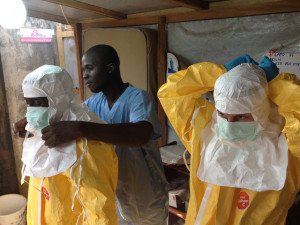Media coverage around the continuing Ebola outbreak has questioned whether or not the virus could in future change its mode of transmission to become airborne, though this is thought to be unlikely.

The coverage follows news of the first imported case of Ebola in the United States, where a man from Liberia was admitted to a hospital in Dallas, Texas, four days after arriving in the country. Authorities are currently monitoring those he may have come into contact with after developing symptoms – none have yet been confirmed as infected.
Our colleagues at the UK SMC have collected the following expert commentary. Feel free to use these quotes in your reporting. If you would like to contact a New Zealand expert, please contact the SMC (04 499 5476; smc@sciencemediacentre.co.nz).
Professor Peter Piot, Director of the London School of Hygiene & Tropical Medicine, and co-discoverer of the Ebola virus, comments:
“To suggest that Ebola could become airborne is completely irresponsible. The way the virus is spreading is consistent with what we’ve seen in all previous 25 outbreaks, only transmitting through blood and bodily secretions. There is no precedent for a virus changing its mode of transmission so drastically. Other viruses such as HIV – which transmit in the same way, have passed through millions of humans, and are known to mutate more than Ebola – have not become airborne. Making such claims is an unwelcome distraction from the urgent need to scale up the international response to the ongoing humanitarian crisis in West Africa.”
Dr Mike Skinner, Reader in Virology, Imperial College London, comments:
“Without “gain-of-function” experiments of the type that have provoked some considerable controversy in recent influenza virus studies, it is impossible for virologists to establish whether viruses are inherently incapable of adopting a new mode of transmission or to assess the likelihood should it indeed prove possible. Work on Ebola virus can only be undertaken in very few high containment laboratories worldwide. There has also been relatively little study of interactions between the docking protein of the virus and the actual, or potential alternative, receptors which allow it to enter human cells in different tissues.
“However, the crucial point is that from humanitarian and global health considerations alone, we have to take all feasible measures to get on top of this outbreak, control it and then stop it circulating amongst humans, which is the best way of limiting any potential risk, however remote, of the virus evolving (by natural mutation and selection) in any undesirable way.”
Dr Alain Kohl, MRC Programme Leader, MRC Centre for Virus Research, University of Glasgow, comments:
“It is very unlikely that this virus would mutate to become airborne. Although we do not know what changes would be required for this virus to acquire an additional mode of transmission and nothing can be completely excluded, it is important to focus on implementing control measures that deal with the situation on the ground as things are and stop further spread into and across local communities.”
Dr Ben Neuman, Lecturer in Virology, University of Reading, comments:
“Ebola is found in the bloodstream, which is part of what makes it so difficult to transmit compared to other viruses. To become airborne, Ebola would need to fundamentally change the way it grows. That is very unlikely in my opinion.
“Evolution can be unpredictable, but there is no good reason to expect that Ebola will become more dangerous with time. Severe diseases like Ebola often happen when a virus clashes with a brand new host for which it is poorly adapted. Recent experience with H1N1 swine flu shows that viruses are likely to mellow as they adapt to their new hosts.
“There is no evidence that Ebola can spread via the air in the real world. Ebola can only be transmitted through the air under carefully controlled lab conditions. One clue that emphasises how different Ebola is from flu is how slow the virus is spreading. Compared to this Ebola outbreak, the H1N1 swine flu had already spread to an estimated 10,000 times as many people in its first ten months.”
Dr Jeremy Farrar, Director, Wellcome Trust, comments:
“The chances of Ebola becoming airborne are extremely small. I am not aware of any viral infection changing its mode of transmission. This is not to say it would be impossible, but it’s important we retain a sense of proportion and not exaggerate the risks for it changing and becoming airborne. There is already enough fear and panic surrounding this epidemic. Of more concern is that the virus could become endemic in Western Africa, so unlike big outbreaks like this we could have smaller numbers of cases but circulating continuously. This is where we need to focus our efforts and attention – on trying to stop this outbreak before it establishes itself in Western African countries.”
Professor David Heymann, Professor of Infectious Disease Epidemiology at the London School of Hygiene & Tropical Medicine, comments:
“No-one can predict what will happen with the mutation of the virus, and there is no evidence to suggest that it will become a respiratory virus. Its epidemiology is consistent with transmission via blood, bodily secretions and excretions, which is exactly the same as other past epidemics. Other viruses that transmit in a similar manner by blood, such as Hepatitis B and HIV, have not mutated in this manner. In order for Ebola to change, the virus would have to develop the capacity to attach to receptors in the respiratory system.”